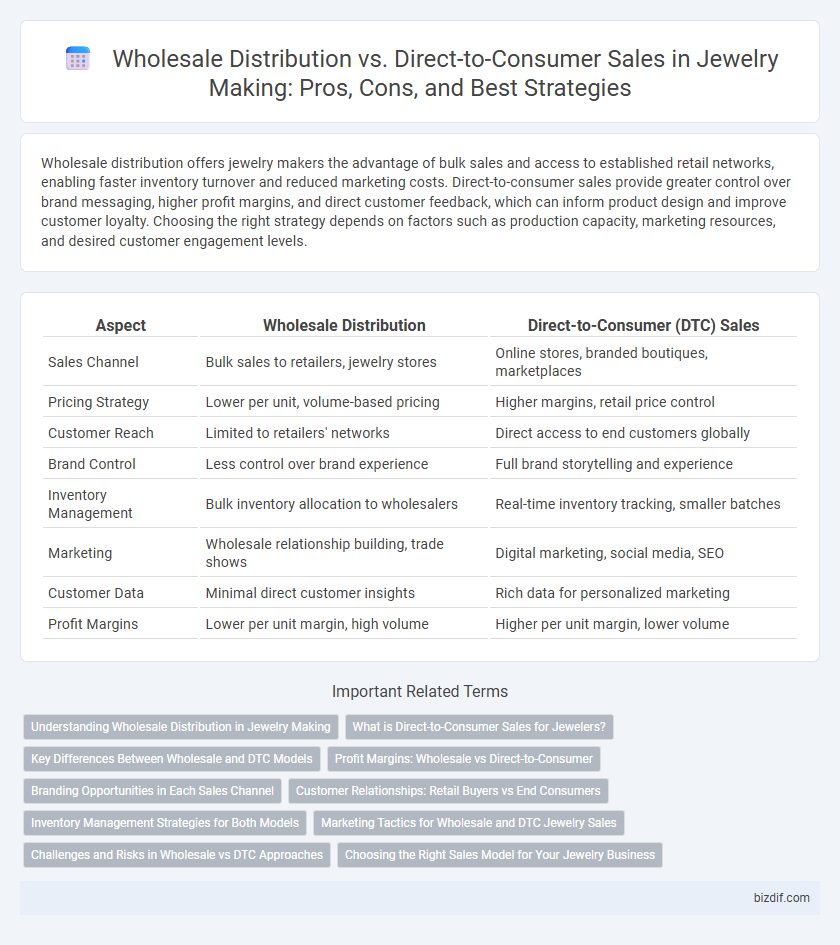Wholesale distribution offers jewelry makers the advantage of bulk sales and access to established retail networks, enabling faster inventory turnover and reduced marketing costs. Direct-to-consumer sales provide greater control over brand messaging, higher profit margins, and direct customer feedback, which can inform product design and improve customer loyalty. Choosing the right strategy depends on factors such as production capacity, marketing resources, and desired customer engagement levels.
Table of Comparison
| Aspect | Wholesale Distribution | Direct-to-Consumer (DTC) Sales |
|---|---|---|
| Sales Channel | Bulk sales to retailers, jewelry stores | Online stores, branded boutiques, marketplaces |
| Pricing Strategy | Lower per unit, volume-based pricing | Higher margins, retail price control |
| Customer Reach | Limited to retailers' networks | Direct access to end customers globally |
| Brand Control | Less control over brand experience | Full brand storytelling and experience |
| Inventory Management | Bulk inventory allocation to wholesalers | Real-time inventory tracking, smaller batches |
| Marketing | Wholesale relationship building, trade shows | Digital marketing, social media, SEO |
| Customer Data | Minimal direct customer insights | Rich data for personalized marketing |
| Profit Margins | Lower per unit margin, high volume | Higher per unit margin, lower volume |
Understanding Wholesale Distribution in Jewelry Making
Wholesale distribution in jewelry making involves selling large quantities of products to retailers or other businesses rather than individual customers, enabling manufacturers to reach broader markets efficiently. This model reduces marketing costs and logistics complexities by leveraging established retail networks, allowing artisans and brands to focus on production and design innovation. Understanding inventory management, pricing strategies, and building strong relationships with retailers are crucial for success in wholesale distribution within the jewelry industry.
What is Direct-to-Consumer Sales for Jewelers?
Direct-to-consumer sales for jewelers involve selling jewelry pieces directly to customers without intermediaries, allowing for personalized service and higher profit margins. This model enables jewelers to build stronger brand loyalty through direct engagement, customized offerings, and exclusive collections. Leveraging e-commerce platforms and social media marketing enhances reach and customer experience, driving sales growth effectively.
Key Differences Between Wholesale and DTC Models
Wholesale distribution in jewelry making involves selling large quantities of pieces to retailers at discounted rates, enabling broad market reach but often resulting in lower profit margins. Direct-to-consumer (DTC) sales allow jewelers to sell directly through online stores or boutiques, increasing profit margins by eliminating intermediaries and fostering stronger brand-consumer relationships. Inventory management, pricing strategies, and customer engagement differ significantly between wholesale, which prioritizes volume and retailer partnerships, and DTC models focused on personalized marketing and customer loyalty.
Profit Margins: Wholesale vs Direct-to-Consumer
Wholesale distribution in jewelry making typically offers lower profit margins, often ranging between 20% to 40%, due to bulk pricing and intermediaries. Direct-to-consumer sales enable jewelers to capture higher profit margins, sometimes exceeding 60%, by eliminating middlemen and selling at retail prices. Maximizing profitability in jewelry involves balancing the volume of wholesale orders with the higher returns of direct sales channels.
Branding Opportunities in Each Sales Channel
Wholesale distribution offers jewelry makers broad market exposure by placing products in multiple retail outlets, enhancing brand visibility through established retailer reputations and customer trust. Direct-to-consumer sales enable brands to maintain complete control over their image, crafting personalized shopping experiences and building deeper emotional connections with customers through tailored marketing and unique storytelling. Both channels provide distinct branding opportunities: wholesale amplifies reach and retailer endorsement, while direct sales foster brand authenticity and customer loyalty.
Customer Relationships: Retail Buyers vs End Consumers
Wholesale distribution in jewelry making establishes long-term, collaborative relationships with retail buyers who prioritize bulk orders and consistent product quality, enabling broader market reach through trusted storefronts. Direct-to-consumer sales foster personalized customer experiences, emphasizing individual preferences, immediate feedback, and brand loyalty by engaging end consumers through social media and customized offerings. Understanding these distinct customer relationship dynamics helps jewelers tailor communication, marketing strategies, and inventory management to optimize sales channels.
Inventory Management Strategies for Both Models
Wholesale distribution in jewelry making requires maintaining larger inventory quantities to meet bulk order demands from retailers, emphasizing efficient bulk storage and turnover rates. Direct-to-consumer sales focus on lean inventory strategies, utilizing just-in-time production and personalized stock management to minimize holding costs and swiftly respond to customer preferences. Both models benefit from integrated inventory management software for real-time tracking, demand forecasting, and supply chain coordination.
Marketing Tactics for Wholesale and DTC Jewelry Sales
Wholesale distribution in jewelry making emphasizes building strong relationships with retailers, leveraging bulk pricing strategies, and utilizing trade shows for lead generation to maximize reach and volume. Direct-to-consumer (DTC) sales focus on personalized marketing tactics such as social media advertising, influencer collaborations, and email campaigns to create brand loyalty and higher profit margins. Both approaches benefit from data-driven targeting and storytelling that highlights craftsmanship, materials, and brand heritage to resonate with distinct buyer personas.
Challenges and Risks in Wholesale vs DTC Approaches
Wholesale distribution in jewelry making often faces challenges like lower profit margins, limited control over brand presentation, and dependency on retailer partnerships for sales volume. Direct-to-consumer (DTC) sales pose risks such as higher marketing expenses, the need for robust e-commerce infrastructure, and the responsibility to manage customer service and fulfillment independently. Both approaches require strategic risk management to balance inventory costs, market reach, and customer engagement effectively.
Choosing the Right Sales Model for Your Jewelry Business
Wholesale distribution enables jewelry businesses to reach a wider market through retailers, offering bulk sales that reduce per-unit costs and increase inventory turnover. Direct-to-consumer sales provide higher profit margins by eliminating intermediaries, allowing personalized customer engagement and better brand control. Evaluating factors such as target market, production capacity, and marketing resources is essential to select the optimal sales model for sustainable growth in the jewelry industry.
Wholesale distribution vs Direct-to-consumer sales Infographic

 bizdif.com
bizdif.com